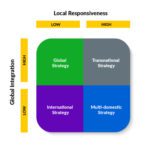Global expansion offers a wealth of opportunities. Yet like any business endeavor, it's fraught with risks and challenges. From local laws to language barriers, companies that "go global" must learn to navigate new markets.
So, it should come as no surprise that even leading companies have failed international expansion attempts. Fortunately, you can increase your odds of success with some strategic planning.
In this article, we cover when to expand, how to plan a business expansion, and the advantages and disadvantages of entering a new market. But before we dive in, let's start with a definition.
What is Global Business Expansion?
Global business expansion is a growth strategy that involves establishing business operations in foreign markets.
Businesses choose to expand when they want to generate more profit or in response to increased competition, domestic success, and potential in new markets.
When Should You Expand Your Business Globally?
Given that international expansion is a major undertaking, it's important to determine whether your business is ready before you take that step. Below are six indicators that it may be the right time to establish business operations abroad:
- There is foreign demand for the product or service.
- Your business has been profitable for more than three consecutive years.
- You consistently keep costs under control.
- You have the resources to expand (financial, personnel, materials, etc.)
- You have external investors that plan to help you fund the expansion.
- Your products or services are ready for localization.
- Your product and services gain cost efficiencies from production in global markets
- Your product requires minimal alterations to viably expand to new markets
If any of these apply to your business, you could find success in market expansion. Here are some key considerations before you implement an international expansion strategy.
Developing a Global Expansion Strategy: 5 Key Considerations
1. Choosing a Model for Expansion
The first step is to determine which of the four strategic models aligns with your business needs and goals. Keep in mind that the model you choose may require you to adapt business operations to meet local regulations.

An International Strategy is usually the first approach a business takes. It focuses on exporting or importing goods while maintaining a headquarters in the domestic market. This requires lower integration and lower responsiveness, similar to an export strategy. Companies that use an international strategy include Harley Davidson, Rolex, and Lindt AG.
Entry strategies include:
-
- Exporting, which involves either direct exporting or indirect exporting through a third-party distributor or reseller. It allows you to enter multiple markets simultaneously. However, it’s challenging to scale without hiring in-country employees or contractors.
- Licensing, which involves granting a local partner (licensee) permission to manufacture and distribute your product. It may require sacrificing some quality control, but it’s an effective entry strategy.
A Transnational Strategy involves operating out of a headquarters in one country which coordinates any subsidiaries in other countries. It requires high local responsiveness and high global integration as well as customizing products to meet local demands. Examples of this are Coca-Cola, Unilever, and KFC.
Entry strategies include:
-
- Franchising, which involves allowing a third-party (franchisee) to operate additional locations for a fee. This method includes help from an outside source, which makes the process quicker and easier.
A Multidomestic Strategy involves using different sales, marketing, and product strategies based on the companies a business is operating. Instead of operating as one global brand, a business develops smaller, country-specific brands that have been adapted to local preferences. It requires high local responsiveness and low global integration. Companies that use a multidomestic strategy include Heinz, Netflix, and Nestle.
Entry strategies include:
-
- Partnering and joint ventures, which can be as simple as co-marketing with foreign brands or as complex as manufacturing and sub-contracting for supply chain management. A joint venture formalizes a partnership and involves creating a new company that operates in the target market.
-
- Mergers and acquisitions, which involve buying out a competitor that operates in the target market. This strategy allows companies to enjoy the competitive advantage of a local firm by leveraging the former company’s resources, knowledge, and staff.
A Global Strategy involves defining one global brand and making few to no changes for other markets. This strategy works well for industries where local preferences are less important than costs, e.g., software and technology. It requires lower local responsiveness and higher global integration. Companies that use a global strategy include Microsoft, Procter & Gamble, Intel, and Lenovo.
Entry strategies include:
-
- Greenfield Investments, which involves restarting the company in a new market—instead of relying on different types of outsourcing. Although it’s one of the most challenging strategies, it can also become the most rewarding.
2. Market Research and Buyer Personas
Once you've chosen a business expansion model, you need to conduct market research to learn more about your target customers. This will help you improve the customer experience and identify key points in the buyer journey. Common market research strategies include:
- Keyword research to identify demand
- Following trends in target markets
- Conducting surveys with local audiences
- Using Trade.gov to research foreign markets
Market research will also help you create buyer personas for the new market, and successfully adapt your brand identity through website localization.
3. Legal Requirements and Regulations
Before you enter a new market, be sure to understand that country’s language access laws. They may have business regulations that differ from your own. To ensure compliance, consider:
- International trade requirements for exporting products from one country and importing them into another.
- Tax laws, including whether the target country has a tax treaty with yours.
- Intellectual property (IP) laws, and how to secure and protect your IP through licenses or other agreements.
- Foreign currency exchange controls, and how to establish secure methods of payment.
- Labor laws and employment, if you’re hiring or subcontracting in a foreign country.
- Corporate structure, if you’re going beyond marketing and sales. A few options include establishing your own branch, subsidiary, or working with an international professional employment organization (PEO).
- Exit strategies, in the event that you need to leave the market.
4. Building and Managing a Global Team
As you expand your businesses' reach, you'll also need to expand your team. That means hiring employees or subcontractors who can respond to international inquiries, understand local markets, and know how to capitalize on the weakness of local competition. Yet finding the right people can be difficult to do remotely due to geographical, cultural, and language barriers.
An international PEO can help you establish a presence in a new market. The organization you hire will help you manage recruitment, HR, payroll, and taxes, while allowing you to remain agile enough to exit the market, if necessary.
5. Website Translation vs. Website Localization
Local language and culture have a significant impact on how your brand is perceived by a targeted audience. This is where website translation and localization come in. Though these terms are often used interchangeably, they are two distinct processes in a global marketing strategy.
Website translation is the process of rendering text from one language into another and is an important aspect of localization.
Website localisation involves more than just translation. It is the process of adapting products, services, marketing, and other content for a target market and includes customizing these elements with a look and feel that matches local cultural preferences. For example, website localization involves:
- Translating text and adapting it for any cultural nuances
- Altering images, colors, or other design elements
- Adapting time and date formats, address formats, currency symbols, and more
What is Transcreation?
As a part of your non-web content adaptation strategy, you may need to engage in a technique called transcreation. this involves reimagining your message to preserve the intent, context, and tone in the new language. This type of translation is usually not word-for-word and leaves room for creative interpretation.
At MotionPoint, we work with you to develop a strong localization strategy to maximize your success in a new market. Our technology and website localisation services give you the tools you need to adapt your message in any language, quickly and affordably.
Pros and Cons of Global Expansion
Now that you know more about global expansion, let’s take a look at a few of the advantages and disadvantages of doing so.
Advantages include:
- Greater financial viability. Larger businesses are often more appealing to investors and lenders, which means you may enjoy more access to capital.
- Creating economies of scale. You can spread the cost of doing business across more markets or customers to lower costs on a per-customer basis.
- Better protection against market changes. Entering new markets can strengthen your business by allowing you to rely on multiple streams of income.
Disadvantages include:
- A shortage of cash. You may need to borrow money to cover the initial expenses.
- Increased capital requirements. You may need to invest in additional facilities or equipment—in addition to a larger workforce.
- Loss of control. An international business must delegate responsibilities across different locations. This can lead to lower quality products and services, unless you have an effective management strategy in place.
Ultimately, whether or not you decide to expand globally will depend on your business goals and stage of development. If the time is right for you, MotionPoint can provide the translation and localization services you need to connect with international customers.
For a limited time, take advantage of our amazing BOGO offer! If you want to test out a new, foreign market like Mexican Spanish, why not try out Spanish for South American markets? If you sign up to get one language, we’ll give you the second for free! Drop us a line today.
Last updated on August 18, 2022

